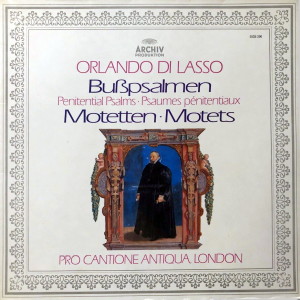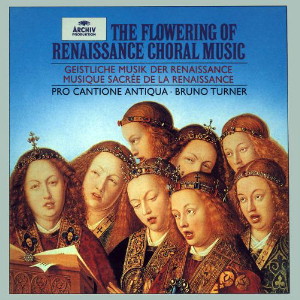 |
|
1 LP
- 2533 290 - (p) 1975
|
 |
| 7 CD's
- 445 667-2 - (c) 1994 |
|
| Geistliche Musik des 15. und
16. Jahrhunderts (Franko-Flämische
Schule) |
|
|
|
|
|
| Orlando di
Lasso (ca.1532-1594) |
|
|
|
|
|
|
| BUßPSALMEN
(Penintential Psalms) |
|
|
|
|
| -
IV. Miserere mei, Dues (Ps. 10/11) |
5 voc. (A / TI /
TII / BI / BII)
|
Psalmus
poenitentialis I-VII, ed, J.
A. Bank, Separatdrucke v.
Annie Bank, Amsterdam u. a.
(1980/84), |
25' 35" |
A1 |
| - I. Domine, ne in furore tuo (Ps.
4) |
5 voc. (A / TI /
TII / BI / BII) |
Septem Psalmi
poenitentiales, ed H.
Büsserle, 1906 |
15'
49" |
B1 |
MOTETTEN
(Motets)
|
|
|
|
|
| - Ave Regina caelorum |
4 voc., soli a
capella |
Lasso-Gesamtausgabe,
ed. F. X. Haberl / A.
Sandberger, Leipzig 1894-1927 |
2' 54" |
B2 |
| -
Salve Regina |
6 voc., a
capella (A / TI / TII / BI) |
Lasso-Gesamtausgabe,
ed. F. X. Haberl / A.
Sandberger, Leipzig 1894-1927 |
3' 59" |
B3 |
| - O
mors, quam amara est |
6 voc., a
capella (AI / AII / TI / TII /
BI / BII) |
Lasso-Gesamtausgabe,
ed. F. X. Haberl / A.
Sandberger, Leipzig 1894-1927 |
6' 16" |
B4 |
|
|
|
PRO CANTIONE ANTIQUA, London
|
Roderick Skeaping,
Diskant-Gambe |
| - James Bowman,
Keith Davis, Paul Esswood, Kevin
Smith, Counter-Tenor |
Trevor Jones, Tenor-Gambe |
| - James Griffett,
Ian Thompson, Ian Partridge, James
Lewington, Tenor |
|
| - Mark Brown,
Brian Etheridge, David Thomas,
William Mason, Bass |
HAMBURGER
BLÄSERKREIS FÜR ALTE MUSIK |
|
- Ulrich
Brandhoff, Zink |
|
- Fritz Brodersen,
Alt-Posaune
|
|
- Hans von Busch,
Tenor- und Bass-Pommer |
|
- Hubert Gumz, Bass-Posaune |
|
|
|
Bruno
Turner, Leitung |
|
|
|
|
Luogo
e data di registrazione |
|
Friedrich-Ebert-Halle,
Hamburg-Harburg (Germania) - 10/15 maggio
1974 |
|
|
Registrazione:
live / studio |
|
studio |
|
|
Production |
|
Dr. Andreas
Holschneider |
|
|
Recording
Supervision
|
|
Dr. Gerd
Ploebsch |
|
|
Recording
Engineer |
|
Wolfgang
Mitlehner |
|
|
Prima
Edizione LP |
|
ARCHIV - 2533
290 - (1 LP - durata 53' 45") - (p) 1975 -
Analogico |
|
|
Prima
Edizione CD |
|
ARCHIV - 445
667-2 - (7 CD's - durata 72' 13", 65' 04",
78' 03", 75' 33", 53' 56", 77' 30" &
66' 38") - (c) 1994 - ADD
CD6 1-12 |
|
|
Cover |
|
Hans Mielich
(1516-1573): Handschrift "Die Bußpalmen
des Orlando di Lasso", Buchminiatur mit
dem Bildnis des Orlando di Lasso.
Bayerische Staatsbibliothek, München (Mus.
Ms. A, 1565-1570) - Archiv für Kunst und
Geschichte, Berlin |
|
|
|
|
Two
things distinguish Lassus among the
great composers of the high Renaissance:
his extraordinary creativity (his list
of individual compositions runs to
something like two thousand) and his
equally extraordinary diversity. Some
degree of fluency is natural to any
genius born into a thriving tradition,
of course; Lassus had the advantage of
being born in the county of Hainault,
which, lying between the episcopal
cities of Cambrai and Liège, had
supplied Europe with some of its finest
composers for three generations and
more. Gilles Binchois had come from
Mons, its capital; Josquin Desprez had
spent the last years of his life a few
miles down-river at Condé; and only a
year or two before Lassus’s birth at
Mons in about 1532, another of the
greatest composers of the period, Claude
Lejeune, had entered the world only
twenty miles away at Valenciennes.
We can assume, then, that Lassus’s early
training as a chorister at the parish
church of St. Nicholas was as good as
any he could have obtained in Europe,
but he was not able to enjoy it for
long. At the age of only twelve or so,
he was pressed into the service of
Ferdinand Gonzaga, the Duke of Mantua’s
younger brother and Charles V’s
commander-in-chief - and also a keen
music-lover who maintained his own
chapel. As soon as his military duties
in the north were finished, Ferdinand
set off for Sicily, where he was the
Imperial Viceroy. Other composers had
made the journey southwards in their
maturity, but Lassus was plunged at an
unusually early and impressionable age
into the most dynamic and cultivated
artistic environment in Europe. He
stayed in Italy some nine or ten years -
first briefly at Palermo, then at Milan,
where Ferdinand was appointed Governor;
later, after his voice broke, he spent a
couple of years at Naples, in the
household of another aristocratic
music-lover, and finally at Rome itself,
where he was appointed choirmaster at
the Lateran basilica in his early
twenties.
After two years in Rome Lassus received
word that his parents were ill and
hurried north to see them, but they were
both dead on his arrival. Talent
gravitates towards prosperity, and for
the next year or two we find him at
Antwerp, the Venice of the north and,
like Venice, a centre of the new
business of music-publishing. Here he
attracted the attention of Duke Albrecht
of Bavaria’s agent, and in the autumn of
1556 he moved to Munich, which was to be
his home for the rest of his life -
nearly forty years, for he died there in
June 1594. But his early travels hatl
alreatly marked him with his chameleon
gift of mimicry: the volume he brought
out with the Antwerp printer Tilman
Susato contained serious antl popular
Italian madrigals, French chansons,
Latin motets both sacred and, more
surprisingly, secular in the new
chromatic style of Rore, almost as if
Lassus, still only in his early
twenties, wished to call attention to
his mastery of all available styles. lt
is a trait of character very
understandable in a young composer,
perhaps less so in an older one. Lassus
continued, throughout his Munich years,
to compose in these diverse genres, even
adding to them that of the German
secular song. His mastery of each is
unquestionable, but his polyglot ability
takes on a manic quality in the
Rabelaisian letters he wrote to the
young Duke Wilhelm, and a psychologist
might well diagnose in this
fragmentation of his identity the roots
of the religious melancholy with which
his last years were increasingly
afflicted.
On this record, though, we are concerned
only with that section of Lassus’s music
- by far the largest - which was devoted
to the church. The earliest surviving
edition of his famous setting of the
seven Penitential Psalms Was published
by the Munich printer Adam Berg in 1584,
but there is some evidence that there
may have been an earlier one in 1579,
the year in which Albrecht died and was
succeeded by his son Wilhelm. That,
however, is not the date of the psalms
themselves; Lassus’s dedicatory letter
to the Bishop of Regensburg tells us
expressly that they had been composed
some twenty-five years previously and
reserved for the Duke’s private use. It
was he who had commissioned them in the
first place, and been so impressed by
their beauty that he ordered them to be
copied in the great parchment
choirbooks, illuminated by the court
painter Hans Mielich, which still
survive as one of the treasures of the
Bavarian State Library. As the humanist
Samuel Quickelberg put it in his
accompanying commentary: “Lassus has so
matched the sound to the sense of the
words, expressing the force of each
affection and presenting the
subject-matter almost visibly, that it
is impossible to say whether the
sweetness of the emotions more enhances
his plaintive music, or his music the
emotions”.
Quickelberg goes on to equate this style
with “that kind of music which is termed
musica reserzvata” - one of the
key passages for the definition of that
much-debated term. It might seem to mean
no more than a connoisseur’s style, in
which clarity of declamation and
subtlety of expression take priority; in
this case, though, it stems rather from
the religious convictions of Lassus’s
patron than from any merely aesthetic
preference. Albrecht was keenly
interested in the movement for the
reform of Roman Catholic church music,
at a time when the whole existence of
polyphony was threatened (not for the
first or the last time) by radical
members of the clergy. The matter came
up for discussion at the Council of
Trent during 1562-63, with further
deliberations by a Commission of
Cardinals in Rome during the two
following years. We can be quite sure
that Lassus’s recently composed settings
of the Penitential Psalms represent, in
their combination of dignified restraint
and subtle expressiveness, the ideal of
a purified polyphony that helped
Albrecht and his party to carry the day.
O mors, quam amara est was one of
the three new pieces contained in a
Parisian collection of Lassus’s five-
and six-part motets published in 1564;
it therefore belongs to the same general
period as the Penitential Psalms, and
shares with them both its air of sober,
not to say sombre, reflection (the
grimly moralising text is taken from
Ecclesiasticus 41, 1-4) and its specific
musical language. Its six voices give
Lassus more scope for textural variety
(a variety he achieves in the Psalms by
reducing the number of voices for
certain verses), and he permits himself
more variety of rhythm, with a
slowing-down for “viro quieto”
and a speeding-up for “et adhuc valenti
accipere cibum”. But it is worth noting
that he avoids the illustrative strokes
that would become commonplace in the
next generation, such as sharp
dissonances for “amara” in the opening
phrase, or any overt eccentricity at
“qui perdit sapientiam”.
The two remaining pieces on this record,
both Marian antiphons, were composed
some twenty years later, to judge by the
dates at which they were copied into the
Munich chapel choirbooks. Neither makes
use of the well-known plainsong
melodies, though Lassus uses those in
other settings; both show him in a
freer, less austere guise. Ave
regina caelorum is an exquisite
miniature for four voices, unified by
its delicate cadential ornaments and
restrained melismas; the rhythmic
vitality of “gaude” and the gentle
pathos of
“vale, o valde decora” are particularly
worth noting, as well as the climactic
rise to “Christum exora” and its
resolution in tenderly descending
scales. Salve regina is utterly
different in character, rich and
homophonic where the other is
transparently contrapuntal. Lassus
divides his six voices here into blocks
of contrasting sound, very much in the
Venetian manner (he was well acquainted
with both the Gabrielis). Here too there
are touches which we might almost regard
as “madrigalisms”: the run on “vita”,
the caught breath before “suspiramus”,
above all the melodic inflections that
underline the pathos of words like
“lacrimarum”, “misericordes”, with the
flat sixth degree (E flat), and the
sweetness of “dulcis virgo Maria” with a
shift from B flat to B natural.
Jeremy
Noble
|
|
|

